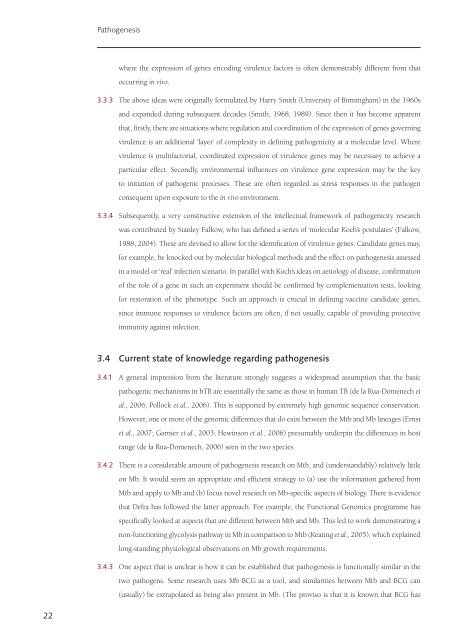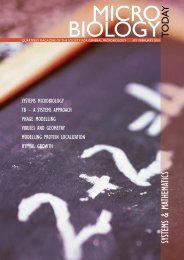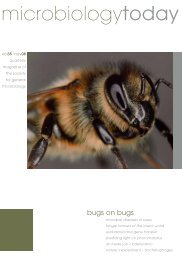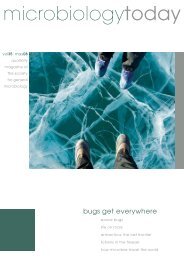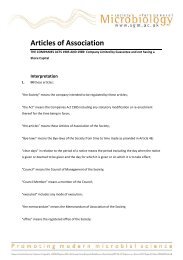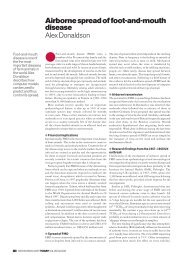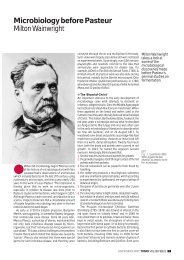final report - ARCHIVE: Defra
final report - ARCHIVE: Defra
final report - ARCHIVE: Defra
Create successful ePaper yourself
Turn your PDF publications into a flip-book with our unique Google optimized e-Paper software.
Pathogenesis<br />
where the expression of genes encoding virulence factors is often demonstrably different from that<br />
occurring in vivo.<br />
3.3.3 The above ideas were originally formulated by Harry Smith (University of Birmingham) in the 1960s<br />
and expanded during subsequent decades (Smith, 1968, 1989). Since then it has become apparent<br />
that, firstly, there are situations where regulation and coordination of the expression of genes governing<br />
virulence is an additional ‘layer’ of complexity in defining pathogenicity at a molecular level. Where<br />
virulence is multifactorial, coordinated expression of virulence genes may be necessary to achieve a<br />
particular effect. Secondly, environmental influences on virulence gene expression may be the key<br />
to initiation of pathogenic processes. These are often regarded as stress responses in the pathogen<br />
consequent upon exposure to the in vivo environment.<br />
3.3.4 Subsequently, a very constructive extension of the intellectual framework of pathogenicity research<br />
was contributed by Stanley Falkow, who has defined a series of ‘molecular Koch’s postulates’ (Falkow,<br />
1988, 2004). These are devised to allow for the identification of virulence genes. Candidate genes may,<br />
for example, be knocked out by molecular biological methods and the effect on pathogenesis assessed<br />
in a model or ‘real’ infection scenario. In parallel with Koch’s ideas on aetiology of disease, confirmation<br />
of the role of a gene in such an experiment should be confirmed by complementation tests, looking<br />
for restoration of the phenotype. Such an approach is crucial in defining vaccine candidate genes,<br />
since immune responses to virulence factors are often, if not usually, capable of providing protective<br />
immunity against infection.<br />
3.4 Current state of knowledge regarding pathogenesis<br />
3.4.1 A general impression from the literature strongly suggests a widespread assumption that the basic<br />
pathogenic mechanisms in bTB are essentially the same as those in human TB (de la Rua-Domenech et<br />
al., 2006; Pollock et al., 2006). This is supported by extremely high genomic sequence conservation.<br />
However, one or more of the genomic differences that do exist between the Mtb and Mb lineages (Ernst<br />
et al., 2007; Garnier et al., 2003; Hewinson et al., 2006) presumably underpin the differences in host<br />
range (de la Rua-Domenech, 2006) seen in the two species.<br />
3.4.2 There is a considerable amount of pathogenesis research on Mtb, and (understandably) relatively little<br />
on Mb. It would seem an appropriate and efficient strategy to (a) use the information gathered from<br />
Mtb and apply to Mb and (b) focus novel research on Mb-specific aspects of biology. There is evidence<br />
that <strong>Defra</strong> has followed the latter approach. For example, the Functional Genomics programme has<br />
specifically looked at aspects that are different between Mtb and Mb. This led to work demonstrating a<br />
non-functioning glycolysis pathway in Mb in comparison to Mtb (Keating et al., 2005), which explained<br />
long-standing physiological observations on Mb growth requirements.<br />
3.4.3 One aspect that is unclear is how it can be established that pathogenesis is functionally similar in the<br />
two pathogens. Some research uses Mb BCG as a tool, and similarities between Mtb and BCG can<br />
(usually) be extrapolated as being also present in Mb. (The proviso is that it is known that BCG has<br />
22


